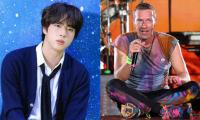Why can’t Jennifer Aniston keep a man?’ ‘Divorced from Brad, now Justin.’ ‘Pregnant at 40?’ ‘Miracle baby at 48?’ ‘Jen’s heartbreak… again!’
Jennifer Aniston has probably experienced the most sexist gossip-magazine headlines of any actor in the last 20 years. Jilted, dumped, shattered, scorned, sad, jealous and childless is what they say. Perhaps the most commonly used prefix to her name is ‘poor’. The irony, of course, is that ‘poor Jen’ is one of the most successful women working in Hollywood today.
She’s been in more than 30 hit films since the day she fell into the Central Perk coffee house dressed as a runaway bride and was typecast (both in her work and her personal life) as the lovable Rachel Green. Divorced again at 49; what’s left for her now? Absolutely everything, actually.
As she turns 50 on Monday, an age that used to see actresses retire or wind down (not often by choice), she is enjoying what is set to be the most exciting period of her career. As well as lucrative advertising deals which have helped her to third place on Forbes’ 2018 list of highest-paid actresses, she has teamed up with Reese Witherspoon to produce and star in a new drama series about the world of breakfast television, Top of the Morning, which was snapped up by Apple as its first scripted TV show after a fierce bidding war.
Her biggest return to the small screen since Friends, which celebrates its 25th anniversary this year, she’s reportedly going to be earning $1.25 million per episode – up from the $1m per episode she and her Friends castmates famously made. (The show is still so popular that the cast make around $20million each annually from repeats.)
Jennifer is among the Hollywood stars who are rewriting the narrative of what a successful woman over 50 looks like in 2019. And we may all reap the benefits.
‘For the last 5,000 years we’ve been telling a wide range of stories about men,’ says Leslie Bennetts, the Vanity Fair contributing editor who has interviewed Jennifer several times, and was the woman she turned to when she was ready to talk publicly about her split with Brad Pitt in 2005. ‘Men have been heroes, warriors, explorers and adventurers, sailing across the seas, inventing things and writing symphonies. But there’s only one main story for women: be young and beautiful, then win the love of a man and have his children. It’s the same whether you’re looking at Homer and The Odyssey, or Jane Austen, or contemporary chick flicks. A lot of women are really tired of it, and Jennifer is one of several established actors now in a position where they can do something about it.’
Some will dismiss film-making as a frivolous place to start if you want to bring about serious social change. But for decades, actresses have spoken of their frustration at the double standards that exist – not least the fact that men have always been seen as ageless. In 2015, a chart went viral that showed lead actors are on average 10 years older than the actress cast as their love interest.
In the wake of #MeToo, and last year’s Golden Globes, where 300 women wore black to protest against gender inequality, there has been a noticeable rise in the number of women pursuing directorial and production roles, attempting to change things from the inside. Already there are more parts being created for experienced actresses. So could the era of favouring the ingénue finally be over?
Olivia Colman, in her 40s, is currently having the greatest run of her career after playing the lead Queen Anne in The Favourite, and has been nominated for an Oscar. Glenn Close, at 71, is also winning awards for her portrayal of a woman who comes to regret devoting her life to her husband in The Wife. Reese Witherspoon, 42, is now a producer who has made films like Gone Girl and the critical and commercial hit TV show in which she also stars, Big Little Lies. There is a seismic shift happening for ‘older’ women in Hollywood, who are now enjoying the greatest moments of their careers post 40.
Jennifer is one of many stars who also makes millions annually from product endorsements – in her career she’s done campaigns for everything from Aveeno moisturiser to Diet Coke. But the difference today is that she may always get to do so. The increasing age diversity on screen is also happening elsewhere: in beauty campaigns, women of all ages are reflecting the fact that, yes, women of all ages buy beauty products. An actress is no longer let go by a beauty company when she hits 30 – or gets her first laughter line.
On the red carpet, it’s actors with a true sense of personal style who are topping the best-dressed lists. People are no longer as excited by newcomers wearing puffballs they have probably been paid to be in. Honest style, honed over decades by someone who knows who they are and what they like, is way more interesting.
Jennifer’s style has always been consistent – she has worked with the sister styling duo Nina and Clare Hallworth on red carpet appearances and film costumes since 2006’s The Break-Up. She has always championed classics over trends, favouring timeless looks – which saw her consigned to the category of ‘safe’ dresser in the fast-fashion dominated 2000s. However, quality investment fashion is what everyone wants to buy now, and Jennifer’s strategy has ensured that she looks ageless in every undated photo.
Ironically, the soap opera around her personal life began, essentially, because a lot of people wanted to copy her outfits – and that haircut. Rachel Green, with her sweetheart silliness and eponymous ‘shag’, made Jennifer a household name at the age of 25. It was a gossip-magazine fairy tale to see the hottest actress on the planet marry Brad Pitt, the hottest actor on the planet in 2000.
Friends ended in 2004, and when Jennifer and Brad split in 2005 – with Brad rumoured to have become close to his Mr and Mrs Smith co-star Angelina Jolie – the tabloid press chose to first cross-examine Jennifer. Had she, at 36, waited too long and put her career before having Brad’s children? Was it all her fault?
When the alleged affair turned into a definite relationship, the line switched to ‘poor Jen’, and tabloids pitted the women against each other, as if they were vying for Brad’s affections. The public bought into it, quite literally: Kitson, the cult Los Angeles boutique, famously reported that its ‘Team Aniston’ T-shirts were outselling its ‘Team Jolie’ ones at a rate of 25-1. ‘I’ve talked about this with Jen several times, she and Brad had decided they were going to start their family when Friends was over,’ says Bennetts. ‘Then Brad went off with Angelina Jolie and started a family life pretty quickly, so Jennifer was vilified and blamed – when that was completely not what had happened. It was cruel and it compounded the difficulty of that transition for Jennifer, but it shows how ambition is stigmatised for women in a way that it isn’t for men.’
Every relationship, friendship or acquaintance that Jennifer had beyond Brad was seen through the prism of the marriage split. Every headline for a decade after the divorce painted her as either still in agony, still pining, or finally fulfilled by new love and a supposed pregnancy.
‘She had some pretty high-profile boyfriends – Vince Vaughn, John Mayer – but whenever she broke up with somebody, the way the story was framed in the tabloid media was back to “Poor Jen, Jen can’t keep a man”, which is nothing but sexist,’ says Bennetts. ‘Nobody said anything like that when George Clooney split up with yet another girlfriend during all those decades he was single.’
Jennifer must have had at least 100 fictional pregnancies during her career. In 2016, when she was married to Justin Theroux, she was photographed in a bikini after she’d had a burger for lunch, and once again gossip columnists speculated as to whether she had a ‘baby bump’.
She decided to write an open letter for the Huffington Post, calling out the body-shaming. ‘For the record, I am not pregnant. What I am is fed up,’ she wrote. ‘I resent… the painful awkwardness that comes with being congratulated by friends, co-workers and strangers alike on one’s fictional pregnancy (often a dozen times in a single day). If I am some kind of symbol… then clearly I am an example of the lens through which we, as a society, view our mothers, daughters, sisters, wives, female friends and colleagues. The objectification and scrutiny we put women through is absurd and disturbing.’
When Jennifer married Justin in 2015, little of that narrative changed. The announcement in February 2018 that they were to divorce only propelled it further, with Brad brought up yet again, and the implication made that because she hasn’t had children she must feel incomplete.
‘I don’t feel a void. I really don’t,’ Jennifer said earlier this month. ‘We live in a society that messages women: by this age, you should be married; by this age, you should have children. That’s the mould we’re slowly trying to break out of.’
‘She’s successful by any metric,’ says Bennetts. ‘And the future seems to be getting only brighter for her at 50, an age when women used to be confined to the trash heap of history in Hollywood. She has survived the worst that fame can inflict on you: being humiliated and misrepresented and having one of the worst disappointments of your life be exploited. But she’s come back again and again with class. She is unsinkable.’
A toast, then, on the eve of her birthday, to the unsinkable, dignified, ageless, successful, unbelievably rich Jennifer Aniston. A woman who is not poor in any sense of the word.—Courtesy The Telegraph
A tree is seen fallen over a house due to a powerful storm in Washington. — Screengrab via Reuters/fileWASHINGTON: A...
United State's President-elect Donald Trump seen in this picture taken on November 6, 2024. — ReutersWASHINGTON:...
Veronika Bagi head of the Hungarian Delegation at UNFCCC, and Jacob Werksman, head of the EU delegation to the...
US President Donald Trump speaks at a press conference with Linda McMahon on March 29, 2019 at Trump's Mar-a-Lago...
Pope Francis blesses the crowd during the weekly general audience on September 25, 2024 at St Peter’s square in The...
US House Speaker Mike Johnson approaches a group of reporters at the US Capitol in Washington. —...







